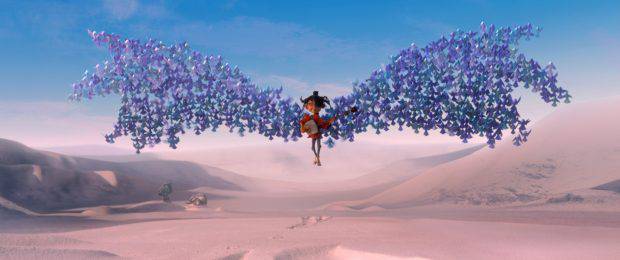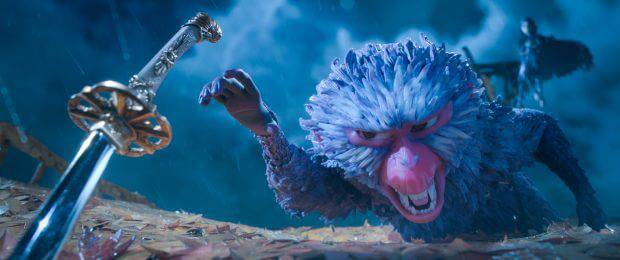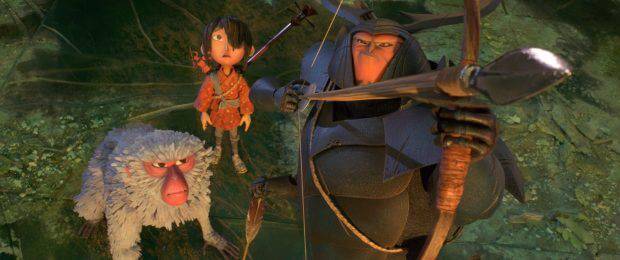‘Kubo and the Two Strings’ Review
Though not the biggest headline grabber of this summer’s mainstream cinematic offerings, LAIKA CEO Travis Knight‘s first directorial effort Kubo and the Two Strings does a far better job of meeting the bar of quality raised by some of 2016’s best features. Aside from its outright technical brilliance, being the biggest boundary pusher of all of the studio’s films thus far, there is a sense of maturity to this film that paints a clearer picture of artistic growth than its 2014 predecessor The Boxtrolls.
https://www.youtube.com/watch?v=vex0gPFnBvM
The film begins dramatically, with perhaps its most prominent use of CG processes as we see a lone woman Siriatu (Charlize Theron) traverse an unforgiving, storm-thrashed ocean, one she can briefly tame with bursts of magic via an enchanted shamisen. When washed ashore we see she has smuggled her child into hiding from evil pursuers who have already taken one of his eyes, pursuers we soon learn are her own supernatural family that she has betrayed to join humankind for the sake of love. As Kubo (Art Parkinson) grows older his own magic charms the local villagers, through mystical performances of animated origami he controls through his music. This charmed life is immediately thrown into disarray when his ailing mother’s seemingly insane proclamations – that her sisters and father will come for his remaining eye should he stay out after dark – prove to be true.
As with previous LAIKA films, the story itself is uncompromising and has no intent of shying away from the heavier subject matter or darker visuals for the sake of coddling its audience. Citing the cinematic epics of David Lean as a crucial influence, at its core are profound themes of loss and isolation, with the newly-orphaned Kubo given no time to acclimate himself to his new circumstances in which he must journey through a variety of unforgiving territories in order to collect the three major components of his deceased father’s armour and seek out his vengeful grandfather. Along the way he is guided by two unlikely sherpas – Monkey (also Theron), a talismanic, carved monkey who has been temporarily brought to life, and Beetle (Matthew McConaughey) a warrior cursed to remember little of his past prior to being transformed into his current half-man, half-beetle state. Rather than traditional allies, the pair serve more as surrogate parents, bickering their way between moments of unsteady teamwork and coming to a begrudging understanding of one another before learning they have a far more significant connection to Kubo than originally thought.
Early in the film one of Kubo’s friends pleads with him to inject more humour into his stories, perhaps as reasurrance to the audience that, although the tone of the first act has seemed largely sombre, LAIKA intend to do likewise. While the dialogue-based humour of the film is not its strength – at times it’s the only element of the entire production that misfires, resorting on occasion to surprisingly obvious asides considering the level of sophistication the rest of the script is capable of – the moments of physical comedy that are peppered throughout, sometimes daringly in moments of high drama, keep the film a truly well-balanced affair. It is not an outright gag-driven feature in the manner of ParaNorman or The Boxtrolls, but there are crucial moments of levity that keep the story from becoming too swamped in its more tragic sequences.
In some respects the film’s story structure almost feels modeled on that of a video game – made up as it is of sequences of increasingly difficult challenges, pursuits and puzzles leading up to ‘boss battle’ sequences that pay tribute to the genre’s forefathers Ray Harryhausen. These villains, brought to life by production designer Nelson Lowry, are the film’s show-stealers, from nightmarish undersea eyeballs (whose time onscreen ends in one of the films more stomach-churning moments) to the now-legendary Giant Skeleton, whose unprecedented scale has seen him the star of several oft-shared time-lapse production videos, to the final monstrous form that Kubo’s grandfather takes of the Moon Beast. Add to this Kubo’s death mask-wearing, chain-wielding Aunts (Rooney Mara) and you find yourself with an array of visual spectacle that at times wouldn’t be out of place in a horror movie. Truly the broadness of the story is matched by the production design itself, with meticulously researched and crafted sets, costumes and geographical characteristics ultimately conveying a world of unfathomable scale, sometimes through the briefest of glimpses.
Most sophisticated of all are the performances of the characters themselves. Save for Beetle, whose facial characteristics have been purposefully restricted, the subtlety of the acting is unparalleled in the world of stop-motion feature production, owed of course to LAIKA’s innovative Rapid Prototyping they’re known and accoladed for; the Kubo puppet alone warranted over 15,000 unique expression components and 20,000 RP-printed faces, with the combination possibilities numbering over 48 million. It is the range of expression that Monkey boasts, considering its seemingly restrictive design, that truly makes the most of the process. Regardless of one’s attitude as to whether or not such a CG-driven process has true fidelity to the craft of stop-motion (I myself am of the mindset that any form of mixed-media experimentation is valuable), the end-result is a joyful one.
Kubo and the Two Strings is out now in UK cinemas. To learn more about the production check out our interview with director Travis Knight.




